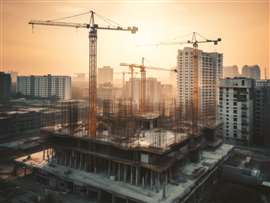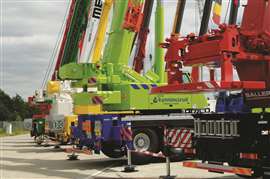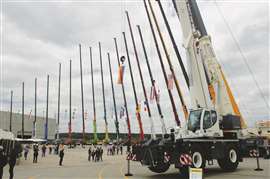Why rental software improves fleet management
07 August 2023
Rental software improves fleet management and as the wider construction industry adopts digital solutions, the crane sector is similarly onboard. Niamh Marriott reports.
 (Photo: Adobe Stock: cendeced)
(Photo: Adobe Stock: cendeced)
As the world fully opens back up post pandemic and supply chain issues slowly ease, the demand for all types of cranes is on the rise globally, and this is providing a plethora of opportunities for crane rental companies.
Construction equipment sales generally, not just cranes, (excluding China) are expected to be up 5 per cent this year and our ICm20 ranking of the world’s largest crane-owning companies, the most recent table from November 2022, showed a total value from crane-related activity of more than US$35 billion.
Business may be booming, but fleet management remains a challenge for many, particularly when expanding operations into different territories across the world. Keeping track of what is where and working out where each crane is going next is a logistical challenge. The current solution on offer is fleet management software and the move to digital organisation.
Big benefits
According to Belgium-based industrial equipment supplier GemOne, the two most significant developments in fleet management solutions are the move by businesses around the world towards full digitisation and the need for owners of machinery to make their fleets more efficient.
“A major challenge for fleet managers in the implementation of access rental fleet management is that their fleet might be made up of vehicles of various brands,” says a spokesperson for the company.
“Factors such as rising insurance premiums and fuel price hikes are driving change, both of which dramatically increase the costs of doing business.
“But there are other factors pushing companies towards fleet management solutions, to facilitate better and quicker maintenance by servicing teams, to improve safety in the workplace for employees, and to meet the demands of current global skills shortages.”
GemOne has developed its Onyx fleet management solution. It allows rental companies to track vehicles, boost efficiency, operate more safely, and avoid unexpected downtime.
The Onyx platform shows the status of access machines instantly: where a machine is located, who is operating it, and when it is due for maintenance.
Capturing this data allows fleet managers to gain insights on which assets to add or disinvest so they can optimise their fleet composition.
It also features GPS tracking, location history and usage reporting as well as remote diagnostics and CAN (controller area network) data, meaning machines can communicate better with each other. Currently, the platform is only available for access equipment.
Fleet management
Analytical fleet management is becoming a necessity for long term profitability across all construction equipment markets, including cranes.
Digital transformation, and the use of rental software have both been at the core of many rental strategies for some time, and it’s a key driver from a product strategy perspective, says UK-based software company inspHire.
Being able to react dynamically to rapidly changing market conditions is key. Not only are businesses being asked to be more sustainable, inflationary pressures are causing costs to increase.
Martin Bestwick, sales director at inspHire, says, “Measuring asset return on investment and business performance accurately during these times is paramount.
“Although rental rates might be slightly higher than others, smart rental businesses are providing their customers with a better service – whether it’s by giving them reminders to off-rent equipment.”
This can be achieved by using inspHire’s alerts system or using the in-depth inspHire APIs to create their own inter-connected customer ecosystem.

Another service, inspHire Corporate allows rental companies to unify and standardise complex processes spread over many business units or geographies into one central rental management enterprise resource planning (ERP) system.
Construction rental companies such as Boels, Riwal, Algeco and Hirepool all have inspHire Corporate at the heart of their businesses.
inspHire has recently added new features including real-time on-location processes such as PODs, repairs, services and vehicle inspections. The company says these will help reduce operational costs by assisting customers in scaling down the use of manual paper documentation.
One of inspHire’s latest products was launched at the Executive Hire Show, which took place in the UK in early February, is the WebPro. The ecommerce solution provides an off-the-shelf B2B/B2C web presence, allowing rental companies to compete online and offline.
“We see this as a game changer for the SME rental company,” says Bestwick. “Historically, implementing such an integrated webshop window was either very costly or limited in terms of true ecommerce functionality.
“We believe WebPro will provide the SME rental or hire businesses with tools to grow their business through the ability to extend their product catalogue and start taking orders for the first time online.”
Digital procurement
There are other areas of the crane industry that are embracing digital solutions. Andrei Geikalo’s digital platform MyCrane was created with the aim of simplifying the crane rental procurement process.
“The current crane rental process is so outdated and complicated and challenging for all parties involved, both clients and suppliers, from the very start,” Geikalo says.
Users enter details of their lifting requirements into MyCrane and receive personalised crane rental quotes from a range of registered crane providers, removing the need for users to contact multiple equipment providers. The company says its online request form is designed to ensure users receive directly comparable quotations. In developing the site Geikalo, a former commercial director at heavy lift and transport giant Mammoet, drew on his industry experience.
Commenting on the potential resistance to digitalisation, Geikalo says, “Initially some people don’t really understand the concept but once they have seen the solution it’s a no-brainer. The crane budget in a construction project is around 15 to 20 %, so it’s a huge portion, and it’s always considered. We have found there is no barrier to digitalisation for crane procurement, people like it. Going digital is happening everywhere in the world, not just cranes, and people can really see what benefits it brings. It’s more the unknown for digital solutions that makes them hold back.
Digital receipt
One the crane has been procured, there are options for digital management of traditional paperwork.
UK-based Capja’s consultancy model intends to digitise all traditional paperwork for cranes – everything from pre work crane checks, operator information, digital signatures and time stamps, to company-branded invoice creation. ICST spoke to Josh Wallman, Capja co-founder and director, who says the pandemic has helped speed up digitalisation adoption.

“Those who haven’t engaged with it yet should be encouraged to do so,” he says. “The benefits are vast and can make site operations run much more smoothly. As an internet connection is not always guaranteed on site, the Capja mobile phone app can download relevant information and then work offline throughout a day’s work, uploading all data once in range of wi-fi.”
The company has also recently introduced QR codes for ease of access to secure information.
Data collection
Berlin, Germany-based Flexcavo is a hybrid rental and software business founded in July 2020 by Benedict Aicher and Leonhard Fricke.
The company, which draws comparisons with USA-based rental and technology company EquipmentShare, develops apps and software for data-enabled workflow and process management, targeting the contractor market. It also has its own rental equipment fleet.
The amount of data that is produced in the construction industry has rapidly increased over the last decade. Denmark-based software company Trackunit, for example, gathers around 1.9 billion data points every single day. The company produces products and services with the stated goal of “eliminating downtime”, of making construction more efficient and productive through the intelligent use of data.
Speaking to KHL Group at last October’s Bauma exhibition in Munich, Trackunit CEO, Soeren Brogaard said, “you can’t really be in this industry unless your product provides data.”
It seems that data is king and software reigns supreme, and as the crane industry moves towards full digitalisation, there are many options already available that can improve fleet management.
STAY CONNECTED


Receive the information you need when you need it through our world-leading magazines, newsletters and daily briefings.




